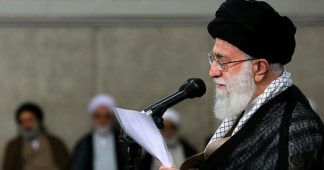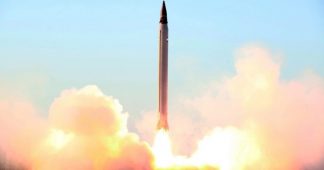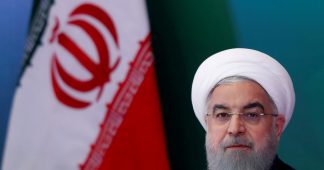By Bill Van Auken
25 June 2019
President Donald Trump and his treasury secretary, Steven Mnuchin, unveiled Monday what the US administration had touted as new “harsh” and “hard-hitting” economic sanctions against Iran in the wake of last week’s Iranian shoot-down of a sophisticated US drone spy plane over the strategic Strait of Hormuz.
The economic measures come in the wake of Trump’s decision, by his own account, to call off air strikes against Iranian missile and radar sites just 10 minutes before missiles were set to fly and with US warplanes already in the air. While Trump claimed he aborted the raids out of concern for Iranian loss of life, it is evident that the real issue was the likelihood that Iran would retaliate, threatening heavy US casualties and a spiraling escalation that could result in a full-scale regional and even global armed conflict.
Despite the advance promotion, the sanctions order signed by Trump at the White House Monday was largely symbolic. They target Iran’s supreme leader, Ayatollah Ali Khamenei, and his appointees as individuals, blocking them from using the US financial system or accessing financial assets in the US.
The administration indicated that it would also add Mohammad Javad Zarif, Iran’s foreign minister, to the list, a highly provocative action that would theoretically expose any world government hosting Iran’s principal foreign policy representative with secondary sanctions.
Trump claimed that his resort to a new round of sanctions, rather than bombarding targets in Iran, demonstrated that “a lot of restraint has been shown by us,” adding, “that doesn’t mean we’re going to show it in the future.” This followed his remark Sunday in an interview with NBC News that if the US were to go to war against Iran “it’ll be obliteration like you’ve never seen before.”
Tehran dismissed the latest sanctions. Iran does not “consider them to have any impact,” Abbas Mousavi told a press conference in Tehran. “Are there really any sanctions left that the United States has not imposed on our country recently or in the past 40 years?”
Indeed, the sanctions regime re-imposed and tightened by the Trump administration since May 2018, when it unilaterally abrogated the 2015 nuclear agreement reached between Iran and the US, China, Russia, the UK, France and Germany, is tantamount to a state of war.
Implementing what it boasts is a campaign of “maximum pressure,” Washington is attempting to drive Iranian energy exports, the country’s principal source of income, to zero. Last month it ended sanctions waivers for several major importers of Iranian oil. Reuters cited energy industry sources as reporting that Iranian crude exports this month have plummeted to just 300,000 barrels a day, a fraction of the 2.5 million barrels per day that it shipped in April 2018, before the US re-imposed sanctions.
Bearing the brunt of these sanctions are tens of millions of Iranian working people, who have seen their real income plummet and their jobs disappear.
The rial, Iran’s national currency, has lost 60 percent of its value, while the inflation rate has soared from 9 percent in 2017 to 31 percent last year, and is expected to reach 37 percent or more this year. The result has been the skyrocketing of prices for basic necessities of life. According to the government’s own statistics, in the year since Washington re-imposed sanctions, meat and poultry prices have risen by 57 percent; milk, cheese and eggs by 37 percent; and vegetables by 47 percent. The real increases are undoubtedly significantly higher.
The official unemployment rate for younger Iranians has risen to 27 percent, and for university graduates to 40 percent. Again, real unemployment is far higher, as the government counts anyone working as little as one hour a week as employed.
While medicine is theoretically exempt from US sanctions, in practice the punishing measures implemented by Washington are depriving millions of Iranians of needed drugs, undoubtedly sending many to early deaths.
European and other international banks and corporations are refusing to participate in financial transactions to allow pharmaceutical companies to ship drugs to Iran out of fear that they will be targeted for US secondary sanctions. And while Iran produces most of the country’s medicines, the raw materials used in making these drugs are often imported.
The Pentagon has continued to build up US military forces in the Persian Gulf, even as top administration officials have traveled to the Middle East in what is billed as a bid to strengthen a US-backed anti-Iranian “coalition.”
The US Central Command (CENTCOM) announced on Monday that the USS Boxer, a Wasp-class amphibious assault ship carrying thousands of US Marines, a squadron of attack helicopters and AV-8B Harrier II strike aircraft, had arrived in the region. It is part of an assault group that includes the amphibious transport dock USS John P. Murtha and the amphibious dock landing ship USS Harpers Ferry.
The amphibious assault group joins the USS Abraham Lincoln carrier strike group and a B-52 nuclear-cable bomber task force, along with 2,500 additional US troops sent to the region since early May under the pretext of “deterring” alleged Iranian threats to “US interests” in the region.
Even as the Trump administration claimed credit for calling off a catastrophic escalation of its assault on Iran in response to the downing of the spy drone, the New York Times and the Washington Post both cited unnamed Pentagon officials as reporting that the US military’s cyber command had carried out cyberattacks aimed at disabling Iranian rocket systems and disrupting an Iranian intelligence unit.
Iran dismissed the claims, insisting that it deflected the US attacks. “They try hard, but have not carried out a successful attack,” Mohammad Javad Azari Jahromi, Iran’s minister for information and communications technology, said on Twitter. “Last year we neutralized 33 million attacks with the (national) firewall.”
An escalation of cyber warfare between the two countries also threatens catastrophic consequences—the bringing down of power grids or possible meltdown of nuclear reactors—spilling over into full scale war.
Meanwhile, the two leading advocates of war and regime-change, US Secretary of State Mike Pompeo and National Security Adviser John Bolton, were in the Middle East promoting aggression against Iran. Pompeo visited Saudi Arabia and the United Arab Emirates, calling his conversations with the rulers of these two absolute Sunni oil monarchies the forging of a “global coalition.” Both the Saudi and the UAE ruling families have long advocated a US war to cripple Iran as a regional rival.
Pompeo’s trip to Riyadh came just a week after the United Nations released a report calling for sanctions against Saudi Arabia’s de facto ruler, Crown Prince Mohammed bin Salman, for his responsibility in the brutal assassination of dissident journalist and US resident Jamal Khashoggi at the kingdom’s embassy in Istanbul last October.
The report cited tape recordings in which members of the assassination squad sent by the monarchy referred to Khashoggi as the “sacrificial animal” and discussed how to chop up and dispose of his corpse.
A State Department official said that the assassination of Khashoggi, who was a columnist for the Washington Post, never came up in Pompeo’s talks with bin Salman. This followed Trump’s own brushing aside of his silence on the matter in his telephone conversation with the crown prince on Friday. “Saudi Arabia is a big buyer of product,” he said, referring to its multi-billion-dollar arms contracts “That means something to me.”
Meanwhile, Bolton was in Israel meeting with Prime Minister Benjamin Netanyahu, another advocate of a US war against Iran. Today he is set to meet with both Israel’s and Russia’s national security advisers in Jerusalem to discuss the Middle East. Washington wants to pressure Moscow into turning against Iran, particularly in Syria, where the two countries have been the principal allies of the government of President Bashar al-Assad against the US-orchestrated war for regime-change.
Asked last Thursday whether Washington and Moscow could sign a deal on Syria, Russian President Vladimir Putin responded: “What does ‘deal’ stand for? This is something about commerce, shares. We trade neither our allies, nor our interests, nor our principles. It is possible to agree with our partners about the solution of various urgent problems.”
Tensions between Washington and its “great power” rivals Russia and China are building over the US war threats against Iran in the run-up to the G-20 summit in Japan at the end of this week. On Monday, Russian Deputy Foreign Minister Sergei Ryabkov denounced the new US sanctions as illegal and “a reflection of the deliberate and purposeful escalation policy.”
The Chinese newspaper Global Times published an editorial Monday stating that it is “only a matter of time before new war breaks out in the region” and quoting Malaysian Prime Minister Mahathir Mohamad, who accused Washington of “provoking” Iran and warned that miscalculations could lead to a “world war.”
The editorial stated that Washington’s demands that Iran entirely shut down its civilian nuclear program, give up its ballistic missiles and curtail its influence in the broader Middle East cannot be achieved by means of economic sanctions. “Unless the US destroys the Iranian regime and subverts Iran culturally, the demands are unrealistic.”
The editorial concluded, “What is worrying is that Washington does not realize that its greedy pursuit of hegemony hides an inherent danger that will cost the world and itself.”
Published at https://www.wsws.org/en/articles/2019/06/25/











